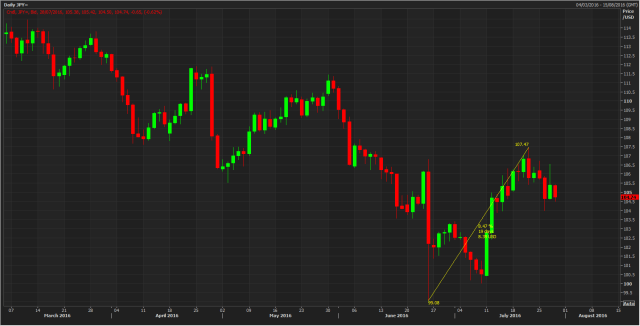Despite assurances made pre-Brexit, a slew of central banks this month have opted to remain in “wait and see” mode as they await further incoming data before properly assessing the impact Brexit has had on their respective economies and how this impact should be addressed.
These central bank assurances have fuelled a wave of easing expectations which have actually seen financial markets responding in a positive and resilient manner to quickly recoup Brexit-driven losses.
Easing expectations have actually been most highly geared not in regards to the BOE or ECB, with the majority of analysts expecting the aforementioned central banks to remain on hold, but in regards to the Bank of Japan.
Data collected by the Bloomberg News BOJ Meeting survey suggests that more than 75% of 41 industry analysts are expecting the BOJ to announce further easing measures this week with the headline -0.10% rate expected to be reduced by a further 10bps at a minimum and a further 20bps at the maximum.
Whilst it is true that financial markets have indeed rebounded quickly from post-Brexit losses and surged higher fuelled by the hope of fresh liquidity, there are a few key reasons why the BOJ seems set to announce further easing this month.
1) Inflation & Inflation Expectations Remain Subdued
The common message of each BOJ meeting last year was one of optimism regarding inflation with the BOJ consistently confirming their confidence in inflation returning to target in the “medium term” and reaching 2% in 2016. However, this was not the case and far from rising to target inflation has actually been drifting steadily lower moving from 0.4% in May last year to -0.4% in May of this year.

Not only are actual inflation readings falling lower but Inflation expectations have also been sliding down the scale with the BOJ Tankan Forecasts, which gives the inflation outlook among Japanese corporates, falling from 1.4% in June last year to 0.7% in June this year. Alongside this deterioration in corporate inflation expectations, household inflation expectations have fallen too with the BOJ’s own household inflation outlook survey for the year ahead falling to 3.8%, the lowest level since the fourth quarter of 2012 pre-QQE.
Indeed, the outlook for inflation is becoming cloudy once again with energy prices starting to tumble as fresh supply-demand imbalances have pushed Oil to new three month lows. These developments have seen a raft of analyst and banks downgrading their oil forecasts for the remainder of the year with demand expected to continue to ebb away.
2)Inflated Easing Expectations
Aside from fundamental reasons for easing, one other important aspect that has been a huge driver of the success/failure of central bank policy decisions in recent years comes down to the level of expectation among market participants. Trader speculation in lieu of the July meeting fuelled 6.3% bounce in USD/JPY as the Japanese Yen was aggressively sold on initial reports of expected easing. Indeed, price action has been so neurotically driven by these easing expectations that comments made by BOJ Governor last week dismissing the prospect of “helicopter money” saw USD/JPY rip sharply lower. It remains to be seen however whether these comments were genuine or simply intended to misguide markets so as to help the BOJ create an element of surprise.

Regardless, with easing expectations so high ahead of the meeting, there is a very real risk that the BOJ is not able to satisfy these expectations and we see JPY heavily bid. Perhaps at this stage it is less a case of fuelling a JPY sell-off and more a case of preventing a JPY rally. Given these inflated easing expectations and the past market response to BOJ action it is difficult to see how the BOJ will be able to effectively capitalise on this momentum and not fall victim to the same fate suffered by the ECB in December 2015 when they disappointed a market highly expectant of further easing.
Volatility ahead of the event is at extremely elevated levels with 1-week volatility reaching highs not seen since the 2008 Global Financial Crisis.

3) Political Developments Pressure BOJ
The final element to the case in favour of BOJ easing comes down to the recent political developments seen in Japan. The re-election of Japanese PM Abe to the Upper House has given a green light to the furtherance of Abenomics and indeed shortly after declaring victory the Japanese PM announced he was order a new wave of stimulus. The size of stimulus was confirmed this week as Y28trln ($265Bln) though details of the composition of the package are yet to be announced. This unusually large fiscal stimulus package puts a great deal of pressure on the BOJ to respond with matching monetary stimulus.
Recent fiscal spending in Japan has ultimately worked against the Japanese Government fuelling a decline in private investment alongside an increased in private savings leading to a crowding out of the private sector. To counter these cycle the BOJ will need to at least offer some forward guidance declaring their intention to refrain from further reducing their balance sheet in future. This move would take Japan closer to dismantling the relationship between consumer’s expectations of current fiscal expenditure resulting in future tax increases
Market Consensus For July BOJ
Current industry forecasts are aligned around a further reduction in rates from -01% to -0.2% alongside an increase in ETF purchases.
Given trader’s reactions to recent Japanese easing and intervention it seems unlikely that the BOJ will be able to achieve its desired outcome through the traditional approach of rates and QE. Though within this approach a surprise increase in the scale of ETF purchases would likely yield a better response with USD/JPY more positively correlated with Japanese equity prices than rate spreads. Moreover, a further reduction of the already negative rates is a complicated issue which could have unintended consequences
Issues With Deep Negative Rates
The BOJ’s move into negative rates in January placed a great deal of stress on domestic banks funded mainly by deposits (59%). With deposit rates near zero, the liability costs of these commercial banks has not yet lessened enough to compensate for the reduced asset revenue from the BOJ’s negative rates policy, leading to a reduction in lending activities. Consequently, a move deeper into negative rates would further squeeze these balance sheet constrained banks limiting their profitability and increasing financial stability risks resulting in weaker equity prices as banking sector stocks decline.
To effectively deliver a weaker JPY will require a combined fiscal and monetary approach outside of the traditional policy responses. If there are signs of debt monetisation and the BOJ funding Government deficits this could result in a significant and sustained turnaround in JPY.
